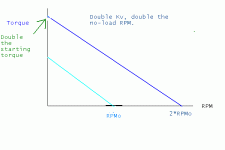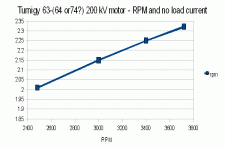[This post had incorrect assumptions about how the typical motor was wound when the kV was changed. As such, the initial starting torque is different as shown in my next post and so is the starting heat.]
If you take a motor and wind it half the amount originally, the kV doubles while the resistance halves. This reduces the torque constant by half, so the torque at 0 rpm will remain the same at a given voltage since the halved resistance implies twice the starting current. This and all future discussion assumes no current limiting.
So, in essence, you don't really seem to change the starting torque. Made sense, there's no such thing as a free lunch, right?
But what I didn't realize is that the higher kV motor version would have a higher peak power. At a given voltage, the doubled kv will have a doubled no-load RPM and the torque at half the no-load RPM will be the same as the torque of the original motor at half of its no-load RPM since the torque is a straight line from the initial torque down to zero torque at the no-load RPM.

Roughly speaking, power = torque * RPM and since the torque at any RPM greater than 0 is higher for the doubled KV motor, the power of the higher KV version of the motor will be higher at a given RPM.
This is quite fascinating, because I originally quite kindly thought those who chose the kigher kv versions of a given motor were fools (Surely lower kV versions would've been easier to gear?) but now I can see why such a preference exists. This also goes quite a ways to explain why these high-kV outrunners are oddly as powerful, if not more so, as the much lower kV and much bulkier hub motors.
However, this extra power doesn't come without a hitch. Generally speaking, you need a higher reduction to make it fit within the same speed range which can reduce efficiency and output power if you start breaking it up into multiple stages. Also, the heat of the higher kV motor will be higher at a given RPM. At 0 RPM, the doubled kV motor has half the resistance and twice the current, but the heat equation is I^2*R, so the heat at 0 RPM is double. Since the higher kV motor generates far more heat at the rpm by which the lower kV motor is running at no-load, it's clear the higher kV motor will run hotter at a given rpm.
But, let's gear it for the same speed range. That is, let's say you simply double the reduction ratio for the higher doubled kV motor to get the same no-load speed (not to be confused with the no-load RPM). Than at the no-load speed, the higher kV motor will have slightly higher cogging torque and eddy current losses since its running at a greater rpm, so the no-load current of the higher kV motor should be at least as great if not greater than the lower kV motor. Let's see... I^2*R - it seems to be a toss up but I think they'll probably be fairly close to each other (Higher kV motor will have a slightly higher no-load current, but half the resistance - If the no-load current is 1.414 or the square root of 2 times greater than that of the lower kv motor, then the no-load heat will be the same). So, at 0 RPM, the double higher kV motor will generate twice the heat and both motor may have similar heat outputs at the no-load speed. So, in essence, the higher kV motor will run hotter.
Summary: higher kV versions = more power. Cons - greater motor heat and greater reductions generally needed. If geared for the same speed, the worst case is twice the motor heat at 0 rpm and the gap decreases to much closer motor heats at speed.
Are there any other cool principles that I haven't figured out yet that may be awesome to know?
I think this may have changed my strategy to get the highest kV without necessitating more reduction stages than necessary. However, not only does a higher kV motor produce more heat, but it also has less thermal mass (it has less windings and the motor may be shorter) to absorb that heat so I may have to be more careful with the motor temperature.
Anyways, this principle is mainly to be applied to different kV versions of the same motor. Like the 6-turn and 10-turn versions of the astro motors, and the 130 kV and 200 kV version of the giant HXT 6-7kW motors. This explains why hobby-city rates the power of the 130 kV version at 6 kW while I believe it rates the 200 kV version at 7 kW.
If you take a motor and wind it half the amount originally, the kV doubles while the resistance halves. This reduces the torque constant by half, so the torque at 0 rpm will remain the same at a given voltage since the halved resistance implies twice the starting current. This and all future discussion assumes no current limiting.
So, in essence, you don't really seem to change the starting torque. Made sense, there's no such thing as a free lunch, right?
But what I didn't realize is that the higher kV motor version would have a higher peak power. At a given voltage, the doubled kv will have a doubled no-load RPM and the torque at half the no-load RPM will be the same as the torque of the original motor at half of its no-load RPM since the torque is a straight line from the initial torque down to zero torque at the no-load RPM.

Roughly speaking, power = torque * RPM and since the torque at any RPM greater than 0 is higher for the doubled KV motor, the power of the higher KV version of the motor will be higher at a given RPM.
This is quite fascinating, because I originally quite kindly thought those who chose the kigher kv versions of a given motor were fools (Surely lower kV versions would've been easier to gear?) but now I can see why such a preference exists. This also goes quite a ways to explain why these high-kV outrunners are oddly as powerful, if not more so, as the much lower kV and much bulkier hub motors.
However, this extra power doesn't come without a hitch. Generally speaking, you need a higher reduction to make it fit within the same speed range which can reduce efficiency and output power if you start breaking it up into multiple stages. Also, the heat of the higher kV motor will be higher at a given RPM. At 0 RPM, the doubled kV motor has half the resistance and twice the current, but the heat equation is I^2*R, so the heat at 0 RPM is double. Since the higher kV motor generates far more heat at the rpm by which the lower kV motor is running at no-load, it's clear the higher kV motor will run hotter at a given rpm.
But, let's gear it for the same speed range. That is, let's say you simply double the reduction ratio for the higher doubled kV motor to get the same no-load speed (not to be confused with the no-load RPM). Than at the no-load speed, the higher kV motor will have slightly higher cogging torque and eddy current losses since its running at a greater rpm, so the no-load current of the higher kV motor should be at least as great if not greater than the lower kV motor. Let's see... I^2*R - it seems to be a toss up but I think they'll probably be fairly close to each other (Higher kV motor will have a slightly higher no-load current, but half the resistance - If the no-load current is 1.414 or the square root of 2 times greater than that of the lower kv motor, then the no-load heat will be the same). So, at 0 RPM, the double higher kV motor will generate twice the heat and both motor may have similar heat outputs at the no-load speed. So, in essence, the higher kV motor will run hotter.
Summary: higher kV versions = more power. Cons - greater motor heat and greater reductions generally needed. If geared for the same speed, the worst case is twice the motor heat at 0 rpm and the gap decreases to much closer motor heats at speed.
Are there any other cool principles that I haven't figured out yet that may be awesome to know?
I think this may have changed my strategy to get the highest kV without necessitating more reduction stages than necessary. However, not only does a higher kV motor produce more heat, but it also has less thermal mass (it has less windings and the motor may be shorter) to absorb that heat so I may have to be more careful with the motor temperature.
Anyways, this principle is mainly to be applied to different kV versions of the same motor. Like the 6-turn and 10-turn versions of the astro motors, and the 130 kV and 200 kV version of the giant HXT 6-7kW motors. This explains why hobby-city rates the power of the 130 kV version at 6 kW while I believe it rates the 200 kV version at 7 kW.





